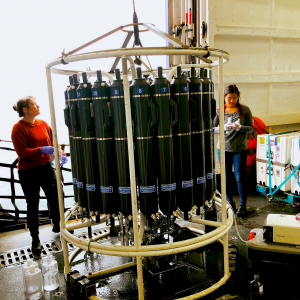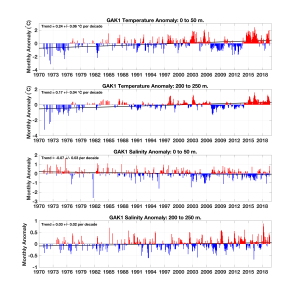2020 Field Season Complete

Despite challenges and restrictions due to COVID-19, the NGA LTER was able to complete their 2020 field operations. These operations included four planned research cruises, and redeployment of several moorings.
To enable this, we shortened cruise lengths, reduced the number of participating scientist, and transferred on cruise to a different vessel. In the end, the NGA team pulled off the core Gulf of Alaska sampling and so maintained the long-term time series datasets.
Fall Cruise Update
During the first 9 days in September, twelve scientists from the University of Alaska (UAF), Western Washington University (WWU) and U.S. Fish and Wildlife Service (USFWS) sailed aboard the R/V Sikuliaq. Originally, the fall cruise was scheduled to take place on the USFWS vessel R/V Tiglax. Unfortunately, the pandemic forced the cancellation of all 2020 Tiglax sailings. Postponement of other research cruises on the Sikuliaq schedule and a slight shift of fall LTER sailing dates opened a window of availability for a fall expedition.
Fall sampling occurred in Prince William Sound and along the Seward Line. This marks the 100th occupation of the Seward Line using a (nearly) modern suite of vertically profiling sondes! The Seward Line is a 150 nautical mile transect that starts at the mouth of Resurrection Bay and extends offshore into oceanic waters. The first occupation of the Seward Line was in December, 1970. Over the first few years, samples were taken only at discrete depth levels using Nansen bottles and reversing thermometers.

A history of the sampling along the Seward Line includes:
- First, sampling at Seward Line stations began with a cruise in 1970. Bottles collected water samples from depth.
- Using profiling dataloggers, 17 full occupations of the Seward Line occurred from 1974 to 1997.
- Then from 1997-2004, sampling expanded to 6-7 cruises per year as part of the U.S. Global Ocean Ecosystem Dynamics (GLOBEC) program.
- From 2005 to 2017, cruises occurred in May and September on the Seward Line and in Prince William Sound. The consortium of funding partners include NOAA, the North Pacific Research Board (NPRB), the Alaska Ocean Observing System (AOOS), and the Exxon Valdez Oil Spill Trustee Council (EVOS) via the Gulf Watch Alaska program.
- Most recently, in 2018 the consortium expanded via funding from NSF’s LTER network. The expansion includes spring, summer and fall expeditions and the addition of survey stations east and west of the Seward Line.
More details and information on the history of our site – https://nga.lternet.edu/about-us/site-history/




